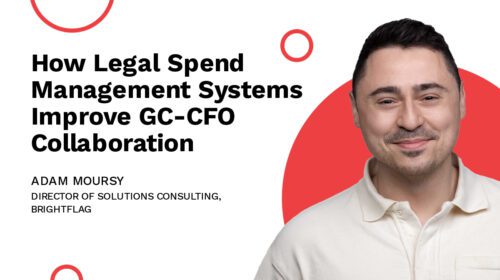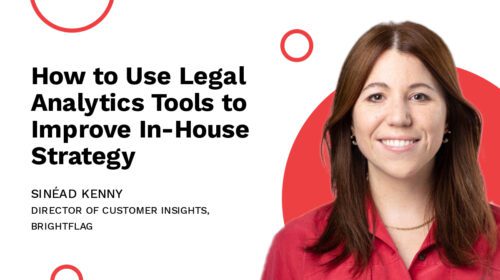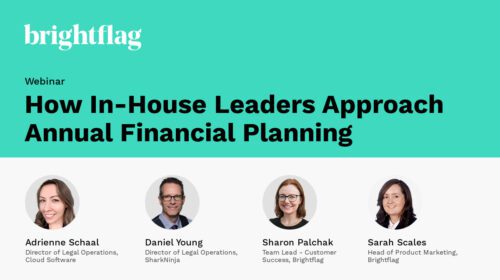Annual Planning Advice from Legal Ops Leader Elizabeth Miller
Elizabeth Miller, a first-generation legal operations pioneer with Financial Planning & Analysis expertise, shares her insights into the legal budget annual planning process in this exclusive interview with Brightflag.
Brightflag: You were the Legal, Compliance, and Government Affairs Finance Manager at Boston Scientific for a few years. How did that role prepare you for your role as Head of Legal Operations?
Elizabeth Miller: A lot of what I was doing within my finance role falls under the umbrella of what is now considered legal operations. Data mapping, spend reporting and analytics, budget management, matter-level balance sheet accounting, benchmarking, forecasting, strategic planning.
Having a solid understanding of how the department (and company) operates, where we’re spending, and how to improve cost control and predictability was a huge stepping stone to tackle new legal ops responsibilities like outside counsel management and drafting department goals and performance metrics that aligned with the Company’s strategic initiatives.
I had also built credibility with Finance and our Executive Team. So there was a strong partnership and sense of trust that allowed us to operate with speed and agility.
Did your previous experience as a financial analyst shape your approach to annual planning of the legal budget as Head of Legal Operations?
Absolutely. I understand the importance of transparency and corporate responsibility. I do not over-inflate budgets because I know that would detract from other investments. I do not waste money. We are all partners in the success of the business.
I prioritize budgets based on impact and am prepared with contingency plans and ROI for investments. If you’re asking for additional funding and don’t have a compelling business case and ROI, you should likely reconsider.
Let’s cover some basics about annual planning. When should it start, and who should be involved?
Assuming your fiscal year starts in January, you should start socializing your technology plans with IT by August or earlier, depending on when they need to lock down capex plans, which often kick off the budget cycle. This is also a good time to discuss which team will manage and budget resources for technology implementations or maintenance.
Confirm with practice group leaders and vendors that all spend incurred year to date is reflected in the general ledger by August as well. And making sure you have accruals for all spend not yet invoiced and that it’s reflected in the appropriate cost centers, GL accounts, and company codes.
This is important because Finance often bases budget targets off of year-to-date run rates. So if you’re missing a couple of million dollars in your year-to-date spend, your budget target will be much lower. Finally, confirm whether Finance will provide budget templates or if you need to create your own.
Starting in September, download year-to-date general ledger spend from your company’s ERP system (SAP, Oracle) and outside counsel spend from your e-billing tool and calculate the run rate or annualized spend by line item by dividing the year-to-date total divided by the number of months year to date times 12.
So if spend through August is $800k, the run rate spend would be $800k/8*12, or $1.2M. Update the current year’s forecast based on the run rate and other anticipated changes and copy this to create the following year’s baseline budget. Build in assumptions for merit increases, growth, price increases, and organizational changes—then review this with practice group leaders.
Sync with HR on headcount assumptions to know if a headcount target or freeze is coming and confirm the pricing of new positions. Connect with RevOps on sales projections that may impact legal spend and headcount needs. Ask Finance to confirm merit assumptions and budget targets (should we assume flat spend year over year?). You should have a decent draft budget that has been reviewed and revised with your leaders by October.
That said, you really need to have ongoing conversations about annual planning throughout the year with all of your practice leaders and stakeholders to communicate and socialize any major changes.
In your experience, what data do you need to inform decisions around legal budget annual planning? And how does a modern legal e-billing platform help during this process?
Year-to-date and prior-year spend is the easiest baseline for drafting a budget. You can then tweak that with assumptions for organization, volume, and price changes you need to collect from the business. For most departments, outside counsel spend is the most significant variable cost, and you can only get a meaningful level of detail on outside counsel spend from an e-billing tool.
Beyond collecting historical spend to create a budget baseline, e-billing data can also be used to review where you’re investing and if that aligns with strategic initiatives. Legal e-billing data can highlight which firms are most cost-effective, how quickly we close matters, and whether staffing ratios make sense for different matter types. This is a great analysis tool for right-sourcing discussions. Are we leveraging cost-effective providers for transactional work and reserving higher-cost firms for our most significant matters?
E-billing data also highlights the department’s efficiency over time: matter volumes compared to the average cost per matter, savings realized, fixed fees versus hourly billings. You can even store diversity and satisfaction ratings within the e-billing platform, which can be leveraged for price negotiations and deciding which firms to abandon or reward.
Some examples of the kind of data you need from the business include:
- Sales/revenue projections
- Is your organization hiring significantly more sales reps (and, consequently, are you planning to increase the magnitude and the volume of legal team support for them?)
- Is there new technology throughout the company that legal needs to support?
- How is headcount projected to trend?
An e-billing platform helps you source data like:
- What is our current run rate?
- What’s our volume of matters, and is it increasing?
- What’s the average matter cost, and how is it trending?
- Which matters are most costly?
An e-billing platform can also help you demonstrate which law firms are submitting invoices on time and how enforcing your billing guidelines impacts this timeline. This knowledge allows you to show that you’re not just spending the organization’s money; you’re saving it, which is a huge asset when you’re asking for next year’s budget during annual planning.
For example, when working with IT, you can say, “Here’s what we need to spend on legal tech next year, and let me show you the ROI on the tools we’ve invested in this past year.”
Let’s discuss what can go wrong with annual planning. What issues have you seen come up for legal operations?
Everything could go wrong. I had a former GC who would say, “Well, we might be right, but we might be wrong.”
We can strive to plan as much as possible, but there is a lot that could happen. You could end up with a major lawsuit that tanks the budget. Or a considerable settlement win. Your company could decide to cut 20% of their overall spend, including legal, or simply take from legal’s budget to invest in another department.
This is why your annual planning and budgeting process needs to include contingency plans. When presenting your annual plan to the executive team, you need more than just a run rate and a list of investments. You also want to show them you’ve considered what allowances you can afford to make—and where, should unexpected issues arise.
For example, if the company loses a sale that requires departments to scale back spending, what spend would legal take out? Conversely, which cuts can legal simply not afford to absorb during an unexpected event without further jeopardizing the company’s trajectory.
If you were speaking with a new legal operations professional about the annual planning process, what is the most critical piece of advice you would want to convey?
Over the past 10 years, legal’s role has shifted from being a cost center to a strategic partner. A partner that’s not just responsible for what’s happening in the legal department but also for shaping how the company is moving forward and helping the company avoid risk.
Because of this, your role in the annual planning process is incredibly important. You’ll have much more success if you’re as proactive and transparent as possible. You want to make sure that everyone involved already knows what you’re planning and nothing is a surprise when you start having conversations about the upcoming year.
Lastly, we share your view legal isn’t a snowflake, and it’s capable of budgeting just like every other department. How do you get to the point where legal is operating similarly while dealing with large matters that can skew costs or law firms are trying to increase rates?
This comes down to agility, clear communication, and transparency. You’ll never have the perfect, accurate estimate for every matter that might come up. But hopefully, you have an open line of communication with business leaders so that legal has a pulse on the business and understands where the soft spots are.
But you also need to bucket the “we don’t know” items and be tapped into what’s happening within the company. For example, we know we typically spend X dollars on this type of matter. Still, because of conversations with business leaders around this topic, we will bump that up by X percent in anticipation of potential changes.
As far as outside counsel goes, you need to be aligned on the scope and what you care about them working on. And then, of course, ensure they adhere to your established guidelines.
And you need to be able to pivot. Delay hires, replace a firm with an ALSP, deprecate an underutilized tool, hold travel for a quarter, move work in-house, push work back to the business, automate, streamline, and standardize.
Also, keep in mind nobody expects legal to adhere to the exact budget laid out during annual planning. Budgets are living documents. If you’re in Q4, you shouldn’t only measure against the budget you created at the beginning of the year. You should be looking at a forecast that’s been updated as changes have occurred throughout the year.
Your living budget should reflect new matters that came up. And if you had a buffer budget you didn’t use, where was that money invested? Legal operations can’t live in a silo. The goal is to start your fiscal year with the most accurate plan you can create. Then, it’s to stay connected to the business so you can understand and adapt to the changes that impact legal’s budget. And then clearly convey those changes and the reasons behind them to leadership.


